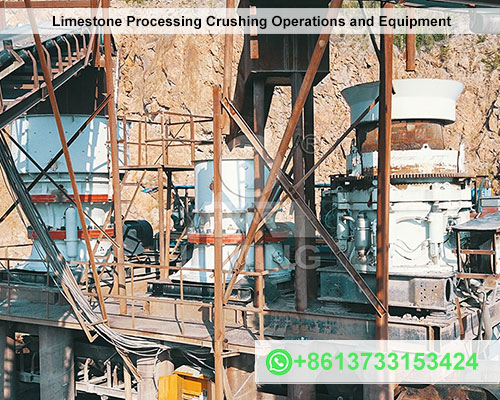Limestone Processing Crushing Operations and Equipment
Limestone is a sedimentary rock composed primarily of calcium carbonate (CaCO3). It is one of the most abundant rocks on Earth and is used in a wide variety of applications, including construction, agriculture, and manufacturing. The processing of limestone typically involves several stages, including crushing, screening, and grinding.

Crushing Operations
Crushing is the process of reducing the size of limestone particles. This is typically done in multiple stages, with each stage using a different type of crusher to reduce the particle size further.
- Primary Crushing: Primary crushing is the first stage of the crushing process and is used to reduce large pieces of limestone down to a size that can be handled by the secondary crushers. Jaw crusher and gyratory crusher are commonly used for primary crushing.
- Secondary Crushing: Secondary crushing is the second stage of the crushing process and is used to further reduce the size of the limestone particles. Cone crusher and impact crusher are commonly used for secondary crushing.
- Tertiary Crushing: Tertiary crushing is the optional third stage of the crushing process and is used to produce very fine limestone particles. Hammer mills and ball mills are commonly used for tertiary crushing.
Screening Operations
Screening is the process of separating limestone particles of different sizes. This is done using a vibrating screen, which allows particles of a certain size to pass through while others are retained. Screening is typically used after each stage of crushing to ensure that the limestone particles are of the desired size.
Grinding Operations
Grinding is the process of reducing limestone particles to a very fine powder. This is typically done using a mill, such as a ball mill or a roller mill. Grinding is used to produce limestone products that are used in applications such as cement production and papermaking.
Equipment Selection
The selection of crushing, screening, and grinding equipment for a limestone processing plant will depend on a number of factors, including the desired product size, the capacity of the plant, and the type of limestone being processed. It is important to consult with an experienced engineer to select the right equipment for your specific needs.
In addition to the crushing, screening, and grinding equipment, a limestone processing plant will also typically include a number of other components, such as conveyors, feeders, and dust collectors. These components are essential for ensuring the smooth and efficient operation of the plant.
Limestone processing is a complex process that involves a number of different stages and operations. The selection of the right equipment and processes is essential for producing high-quality limestone products that meet the specific needs of the customer.









